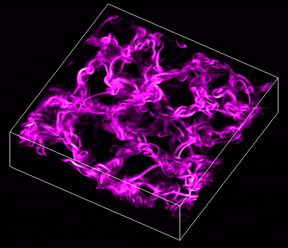
Solar Convection and Magneto-Convection Simulations
Objective: Our objective is to understand convection in the solar envelope: its role in transporting energy and angular momentum, in generating the solar magnetic field, in providing energy to heat the solar chromosphere and corona, in exciting p-mode oscillations, and in modifying their resonant frequencies.
 Approach: We solve the equations of mass, momentum and energy conservation, the induction equation, and the equation for LTE radiative transfer. We use a third-order leapfrog predictor corrector in time and calculate spatial derivatives using third- and sixth-order fits to the functions.
Approach: We solve the equations of mass, momentum and energy conservation, the induction equation, and the equation for LTE radiative transfer. We use a third-order leapfrog predictor corrector in time and calculate spatial derivatives using third- and sixth-order fits to the functions.
Accomplishments: We continued a realistic simulation of convection near the solar surface on a grid of 253 x 253 x 163 with a grid size of 25 km horizontally and 15 to 35 km vertically. Increasing the resolution dramatically increases the vorticity (figure 1) and produces finer-scale structures, but does not significantly alter the buoyancy driving (figure 2) or energy transport properties of the convection. Where the simulation can be compared with observations, such as the emergent intensity (figure 3), the results are very similar.
Significance: Understanding the effects of convection on p-modes will improve our ability to probe the solar interior using helioseismology. Storage of magnetic flux below the convection zone and diffusion of flux at the solar surface are important ingredients in the solar cycle dynamo, which influences the Earth's weather and ozone layer. Transport of angular momentum and mixing into the stable interior effects the evolution of stars.
 Status/Plans: We will study magneto-convection by adding a magnetic field to a snapshot of hydrodynamic convection. We will look for the effects of the field on the convective properties and the p-mode eigenfrequencies, and we will study how convection shuffles around the magnetic field and produces thin magnetic flux tubes. We will also continue our deep convection simulations with an imposed differential rotation. We will investigate the possible role of differential rotation in producing large-scale toroidal magnetic flux concentrations at the bottom of the convection zone.
Status/Plans: We will study magneto-convection by adding a magnetic field to a snapshot of hydrodynamic convection. We will look for the effects of the field on the convective properties and the p-mode eigenfrequencies, and we will study how convection shuffles around the magnetic field and produces thin magnetic flux tubes. We will also continue our deep convection simulations with an imposed differential rotation. We will investigate the possible role of differential rotation in producing large-scale toroidal magnetic flux concentrations at the bottom of the convection zone.
Point of Contact:
Robert F. Stein
Department of Physics and Astronomy
Michigan State University
stein@pa.msu.edu
517-353-8661
URL: http://www.pa.msu.edu/~steinr/
Table of Contents | Section Contents -- Applications Software | Subsection Contents -- Guest Computational Investigators
 Approach: We solve the equations of mass, momentum and energy conservation, the induction equation, and the equation for LTE radiative transfer. We use a third-order leapfrog predictor corrector in time and calculate spatial derivatives using third- and sixth-order fits to the functions.
Approach: We solve the equations of mass, momentum and energy conservation, the induction equation, and the equation for LTE radiative transfer. We use a third-order leapfrog predictor corrector in time and calculate spatial derivatives using third- and sixth-order fits to the functions.
 Status/Plans: We will study magneto-convection by adding a magnetic field to a snapshot of hydrodynamic convection. We will look for the effects of the field on the convective properties and the p-mode eigenfrequencies, and we will study how convection shuffles around the magnetic field and produces thin magnetic flux tubes. We will also continue our deep convection simulations with an imposed differential rotation. We will investigate the possible role of differential rotation in producing large-scale toroidal magnetic flux concentrations at the bottom of the convection zone.
Status/Plans: We will study magneto-convection by adding a magnetic field to a snapshot of hydrodynamic convection. We will look for the effects of the field on the convective properties and the p-mode eigenfrequencies, and we will study how convection shuffles around the magnetic field and produces thin magnetic flux tubes. We will also continue our deep convection simulations with an imposed differential rotation. We will investigate the possible role of differential rotation in producing large-scale toroidal magnetic flux concentrations at the bottom of the convection zone.